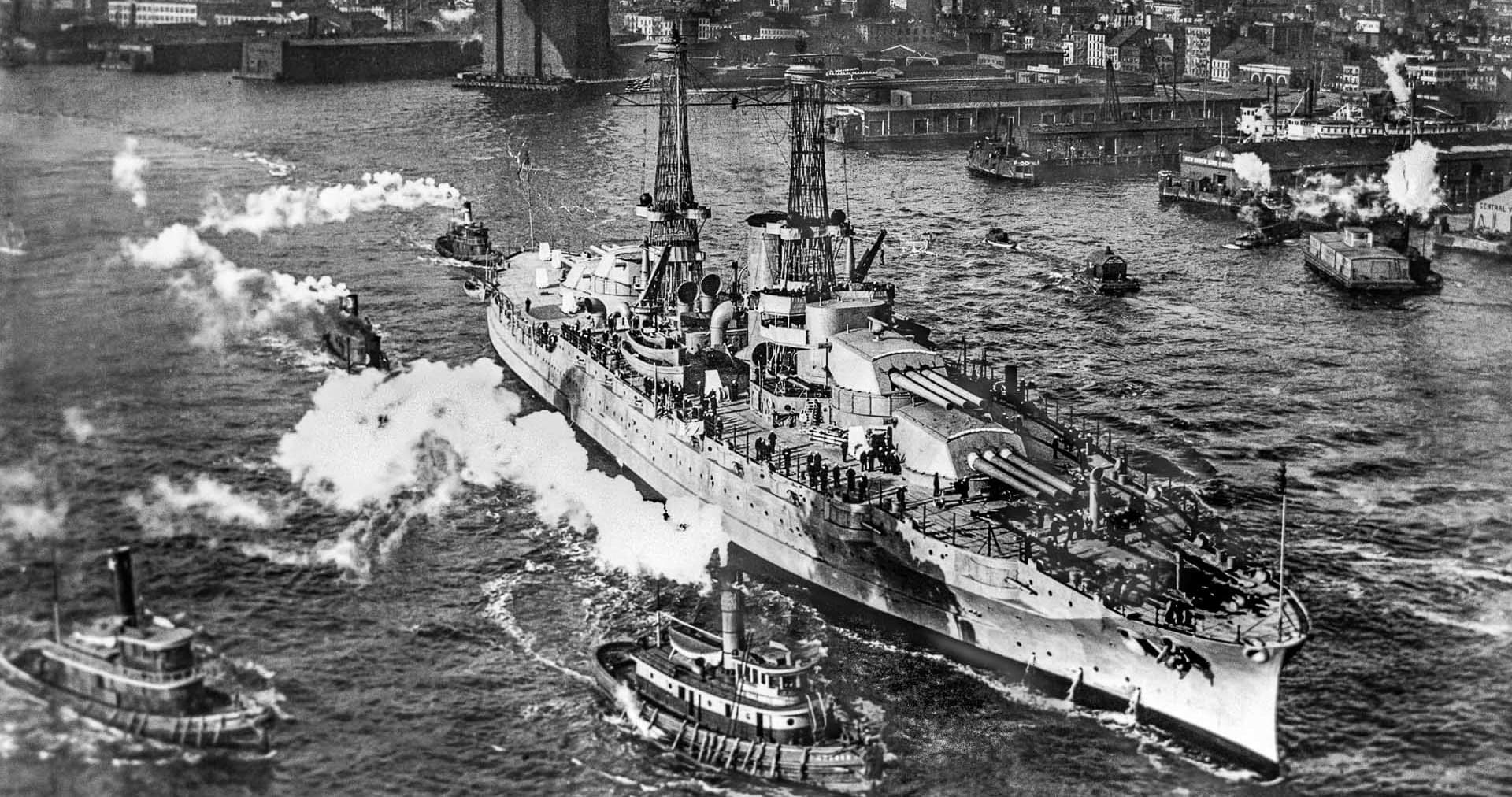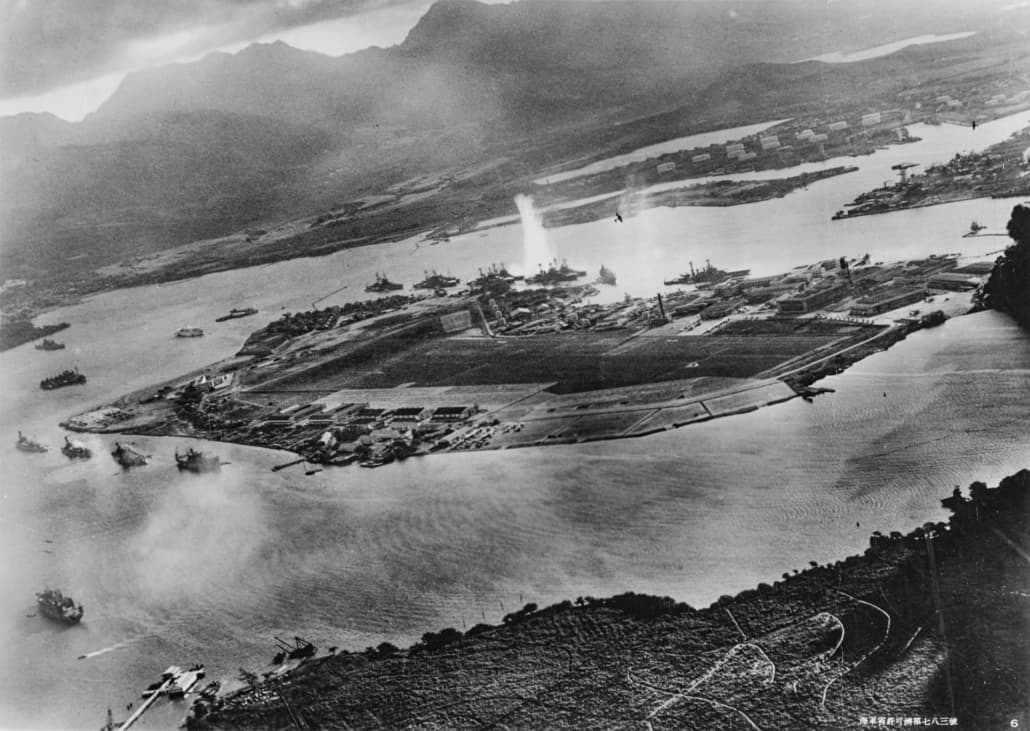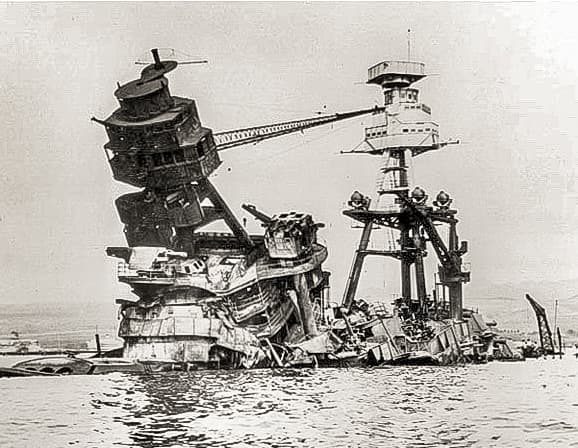USS Arizona – Battleship
Learn About the Battleship Arizona
Few moments in history caused as much change to the world as the Japanese attack on Pearl Harbor on December 7th, 1941. The US entered World War II the next day causing a ripple effect across the world as close to a dozen countries entered the now global conflict.
The attack, even though the losses were devastating, became a rallying cry for revenge that catapulted the U.S. to victory on both sides of the world and led to the United States becoming a global superpower.
The loss of 2,403 lives during the attack was catastrophic, but few were more horrific than the explosion that sank and entombed 1,104 men aboard the USS Arizona.
The USS Arizona was built in the early 1910’s and commissioned in 1916 but remained stateside until the end of WWI. The ship was not sent to Europe during the war as the British Navy used coal fired boilers and the Arizona used fuel oil, which was not readily available in Britain.
The ship was used to escort President Woodrow Wilson to the Paris Peace Conference after the war in 1917 and spent some time near Turkey in 1919 but was soon transferred to the Pacific Fleet in San Diego. In 1920 the Arizona began carrying airplanes on board launched from catapults off the deck. The planes were used for scouting and spotting shell landings from the ship’s guns.

The USS Arizona Battleship’s main battery consisted of four turrets carrying triple 14-inch guns, two turrets forward and two aft. Their maximum range was around 12 miles. Twenty-two 5 inch guns on both broadside hulls (11 per side) defended against torpedo boats with a range of just under 8 miles. Along with four 3 inch guns for anti-aircraft defense, Arizona was also mounted with two torpedo tubes and the ship was stocked with a total of 24 torpedos.
Modernized in 1929 Arizona received new tripod masts while the number of 5-inch guns were reduced to 12 and repositioned one deck higher. Eight more 5-inch anti-aircraft guns replaced the four 3-inch guns. The main gun turrets were upgraded to elevate 30 degrees from the original 15 degrees, increasing their range. More powerfully geared turbines replaced the high-pressure turbines and six new boilers replaced the originals giving her a top speed of 20 knots (23.8 mph).
In 1931 Arizona hosted president Herbert Hoover for a brief vacation in the Caribbean. Afterward the ship was used for training and in 1933 provided aid after a 6.4M earthquake struck Long Beach California killing over 115 people. A year later the ship was featured in a Jimmy Cagney movie “Here Comes the Navy” in 1934. Crew members were extras during the filming of the romantic comedy.
The ship was refitted again in 1940 with more anti-aircraft armaments, four water-cooled machine guns, and search radar. After the upgrades, she was transferred along with the rest of the Pacific Fleet to Pearl Harbor as a deterrent to Japanese aggression in Southeast Asia.
Pearl Harbor In 1941

Japanese aggressions in China prompted action from several countries involved in trade throughout Southeast Asia. Japan was a small country with few natural resources and needed to expand its territory in order to provide for its economic growth.
The Japanese were in a desperate situation as the Dutch in the East Indies, the British in Malaysia and the U.S. in the Philippines put an embargo on rubber, rice, and oil – important commodities that were essential to Japan’s growing military empire. Plans were drawn up and training began in 1940 for simultaneous attacks throughout Southeast Asia, the Philippines, and Pearl Harbor in Hawaii. The objective was to secure the resources Japan needed in Asia and knockout the Pacific Fleet at Pearl Harbor disabling the United States’ ability to counterattack their invasions in Southeast Asia.
Six Japanese Imperial aircraft carriers with 353 planes traveled 3,400 miles across the Pacific to attack the United States without warning. The Japanese chose to attack on Sunday as they believed the US Navy fleet would be more relaxed and less alert on a weekend. They achieved complete surprise as many sailors were still in their pajamas or eating breakfast in the mess halls when the attack began at 7:55 am.
Two waves of Japanese torpedo bombers, high-level bombers, and fighter bombers kept up the attack for just under two hours targeting the U.S. fleet and aircraft bases. Airfields throughout the island at Hickam, Wheeler, Bellows, and Ewa as well as Schofield Army Barracks and Kaneohe Naval Air Station. The first wave destroyed 188 planes on the ground before moving on to attack Pearl Harbor. Torpedo bombers struck battleship row as well as several other ships near the dry docks.
6:00 am – The first wave of 183 Japanese Navy aircraft takes off from their carriers, just north of Oahu, to make the 230-mile trek to Oahu.
7:02 am – Enemy planes detected by radar, by two Army personnel, but junior officer disregards, thought it was Boeing B-17 planes due to arrive from California.
7:15 am – 2nd wave of 167 Japanese Zero planes takes off from their carriers towards Oahu.
7:53 am – The first wave of attack begins. 50 medium bombers, 43 A6M Zero fighters, and 40 Kate torpedo bombers.
9:00 am – The second wave of attack swoops in attacking targets of opportunity including auxiliary ships and facilitates in the harbor.
9:45 am – Attack ends. Over 2,400 people are killed, 1,177 are wounded. 1,104 sailors perish within the hull of the battleship USS Arizona.

There were eight battleships at Pearl Harbor that day and seven of them were lined up on “Battleship Row”. All eight were bombed and/or torpedoed although only two were a complete loss (Arizona and Oklahoma). A total of 18 ships were sunk or run aground including five battleships. Of the 8 battleships attacked, six were able to be repaired and put back into service within months of the attack.
In the second wave of Japanese planes, 10 “Kate” bombers at an altitude of 9,800 ft dropped armor-piercing bombs on battleship row. The bombers scored four hits that ran the length of the Arizona and three near misses. The first hit the stern and ricocheted off Turret #4, penetrating the deck and landing in the captain’s pantry causing a small fire. The next hit was near the port edge mid-ship, blasting a hole in the anti-torpedo bulkhead. The next struck near the port rear 5-inch anti-aircraft gun. The last bomb penetrated the armored deck near Turret #2 and entered the ammunition magazine causing a cataclysmic explosion of an ammunition magazine that blasted the ship almost in half. This explosion killed 1,104 of the 1,512 crewmen on board and accounts for about half of the people killed that fateful day.
A total of 2,335 U.S. servicemen (2,008 Navy sailors, 109 Marines, and 218 Army soldiers and airmen) were killed and 1,142 wounded in the attack. 68 civilians were also killed and 35 wounded.
The next day on December 8th President Roosevelt declared war on Japan in his famous “day of infamy” speech. The explosion of Arizona’s magazine caused the ship to burn for two days.
Arizona’s surviving superstructure was scrapped in 1942 and her armaments were salvaged over the next year and a half. The main aft gun turrets were used in Army artillery installations as Battery Arizona at Kahe Point on the west coast of Oahu and Battery Pennsylvania (Arizona was a Pennsylvania class battleship) on Mokapu Peninsula covering Kaneohe Bay at what is today Marine Corps Base Hawaii. Battery Pennsylvania was fired for the first and last time on V-J Day in August 1945 while Battery Arizona was never completed. The guns from forwarding Turret #2 were salvaged, straightened, realigned, and installed on the battleship Nevada in 1944. The guns were fired against the Japanese islands of Okinawa and Iwo Jima.

The Japanese made several key mistakes in their attack. One was that the U.S. aircraft carriers were out to sea and not in Pearl Harbor. The Japanese knew this and decided to attack anyway before they were discovered. They also decided not to send in the third wave of planes to bomb the repair facilities and submarine base allowing the U.S. to quickly repair the fleet and send out attack subs against Japanese shipping in the Pacific immediately.
Japanese commanders also decided not to bomb the fuel oil storage areas as the smoke would limit the attacking pilot’s view of targets. They were targets for the third wave of the attack which was canceled due to the loss of surprise and fear of attack from U.S. carriers. Had they done so it would have stopped the fleet from deploying anything for an estimated two years instead of the mere months it took to do repairs and get most of the fleet back into the fight.